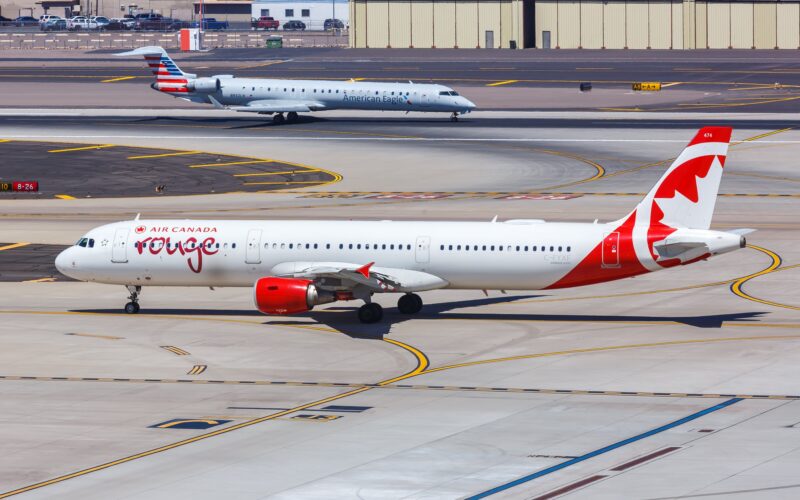The United States (US) National Transportation Safety Board (NTSB) published an incident report about the near-miss at Sarasota-Bradenton International Airport (SRQ), Sarasota, Florida, US, between an American Airlines Boeing 737 and Air Canada Rouge Airbus A321. According to the report, at their closest proximity, the two aircraft were separated by 0.6 miles (965 meters) horizontally.
On February 16, 2023, the Air Canada Rouge Airbus A321, registered as C-GKFB, operated flight AC1633 from SRQ to Toronto Pearson International Airport (YYZ), Canada. At 8:59 PM local time (UTC -5), the Canadian airline’s flight crew was cleared for takeoff on runway 14 by air traffic control (ATC). At the same time, the American Airlines Boeing 737-800, registered as N826NN, operating flight AAL2172 from Charlotte/Douglas International Airport (CLT) to SRQ, was also cleared to land on the same runway.
Analysis of radar data at the airport showed that the American Airlines crew contacted the local controller (LC) about 10 mi (16 km) away from the airport, and the LC cleared the Boeing 737 to land on runway 14. When the flight from CLT was on a 3.12-mi (5 km) final approach, the LC inquired whether the Air Canada Rouge flight was ready for departure, to which the flight crew responded affirmatively.
The LC cleared the Airbus A321 to take off from runway 14, advising them of traffic, namely that flight AAL2172 was on a 3-mi (4.8 km) final approach. 13 seconds later, the controller informed the American Airlines crew that the A321 was departing the same runway on which they had been cleared to land.
Self-initiated go-around
However, as the Air Canada Rouge aircraft failed to clear the runway fast enough, the American Airlines pilots were forced to self-initiate a go-around to avoid a collision.
The Boeing 737 was on a 1.53-mi (2.4 km) final approach when the Air Canada Rouge asked the LC to confirm the departing heading, with the controller responding that the A321 was to fly the runway heading. “About 53 seconds later, AAL2172 informed the controller they were executing a pilot-initiated go-around,” the NTSB noted in its preliminary report.
Subsequently, the LC gave instructions to the American Airlines crew to “turn right to a heading of 270 degrees and to contact the Tampa Departure Control for re-sequencing”. The board highlighted that the closest proximity between the Boeing 737 and Airbus A321 “was 0.6 mi (965 m) horizontally and the same altitude”.
The Air Canada Rouge aircraft “was departing runway 14 and climbing through 100 feet, and AAL2172 was about 100 feet, and crossing over the runway 14 numbers,” the NTSB added in its depiction of the sequence of events.
Investigators conducted interviews with ATC and examined the Federal Aviation Administration’s (FAA) communications records associated with the incident on March 7, 2023. Furthermore, pilots from both airlines provided statements, with “follow-on flight crew interviews are being considered”. The NTSB is also awaiting recorded flight data from Air Canada, the parent company of Air Canada Rouge, and American Airlines.
To investigate the incident, the NTSB formed an ATC group, involving the FAA and the National Air Traffic Controllers Association (NATCA). The US-based investigators also notified the Transportation Safety Board (TSB) Canada and France’s Bureau d’Enquetes et d’Analyses (BEA) about the incident. The TSB assigned an accredited representative and designated Air Canada as its technical advisor.
None of the passengers or crew were injured on either flight. The American Airlines 737 was carrying 172 passengers and six crew members, while the Air Canada Rouge flight had 188 passengers and six crew members onboard.
The near-miss at SRQ is one of a number of incidents currently under investigation by the NTSB.
According to the board’s chairwoman Jennifer Homendy, the NTSB is currently looking at six runway incursions, two wrong-runway landings, and two significant events in Hawaii, US. Homendy, who spoke during the FAA’s Safety Summit on March 15, 2023, stated that “the absence of a fatality or an accident doesn’t mean the presence of safety”, and that the industry should not “take this for granted”.

